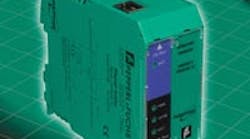Rapid advances in technology are fast overcoming Ethernets limitations.
Its lack of determinism is being addressed in two ways. First, communication rates have advanced from 10 megabits per second to the most recent 802.ae 10-gigabit-per-second standard. Secondly, Ethernet deployments in the industrial arena often feature protocols that allow users to prioritize one type of network traffic over another.
Pepperl + Fuchs FieldConnex Ethernet isolator
Using presently available technology, passing an Ethernet cable through a hazardous area or to a protected enclosure in a hazardous area is expensive and inconvenient. The Ethernet cable must be encased in an explosion-proof conduit system and appropriately sealed as the conduit passes from the hazardous to the nonhazardous area.
A device has been needed that would limit the energy that the Ethernet cable could deliver to a safe level. This device would make the Ethernet cable installation intrinsically safe by limiting the energy that could be delivered from the non-hazardous to the hazardous area.
Designing such a device has been problematic because it is difficult to limit energy while still allowing full high-speed Ethernet communications data to pass through the device. Pepperl+Fuchs has overcome the design difficulties in its new FieldConnex Ethernet isolator.
The isolator combines intrinsically safe energy limitation and galvanic isolation into one product. It can be installed in a safe area, a Zone 2 or Zone 1 area, when housed in a suitable enclosure. Two isolators must always be used in conjunction, as combining the isolators creates an intrinsically safe link that can be run through a Zone 0 or Zone 1 hazardous area.
The galvanic isolation eliminates equi-potential bonding and solid grounding between the area of installation and the connection point in the hazardous area. Combined with safe energy limitation, it eliminates the need for special hazardous-area conduit installations.
Costly and inflexible installations are obsolete and a thing of the past with our new Ethernet isolator, says Robert Schosker, product manager at Pepperl+Fuchs. Its energy-efficient design produces very low heat dissipation, a definite advantage when cabinet space is tight and costly. And long-lasting performance is ensured through the superior electric circuitrya fundamental benefit of all Pepperl+Fuchs products and a basic requirement for any process plant today, adds Schosker.
Ethernet signals supported are 10 and 100 mega bits per second. Gigabit Ethernet is presently not supported, but may be in future product releases. All connector types are RJ45.
Each device has two Ethernet ports, one intrinsically safe and one not. The cable length between the two intrinsically safe isolator ports, one at each device, must be 100 meters or less. The connecting cable must be type CAT5e. Half/Full duplex and auto-negotiation communications are supported. The isolator has indicating LEDs for power, communication and transfer-rate recognition.
Each devices nonintrinsically safe port connects to an Ethernet switch, hub or device. Ambient temperature range is minus 40 °C to plus 60 °C. The isolator complies with all applicable IEEE standards.
A specialized PCB-mounted version of the isolator is designed for original equipment manufacturers that want to incorporate the isolator into their products.
The FieldConnex Ethernet isolator represents a quantum leap forward by providing a superior installation technology for hazardous area applications, concludes Schosker.
For more information, contact Pepperl+Fuchs at 330-486-0002 or at [email protected].
Additional information is also available at www.FieldConnex.info.




